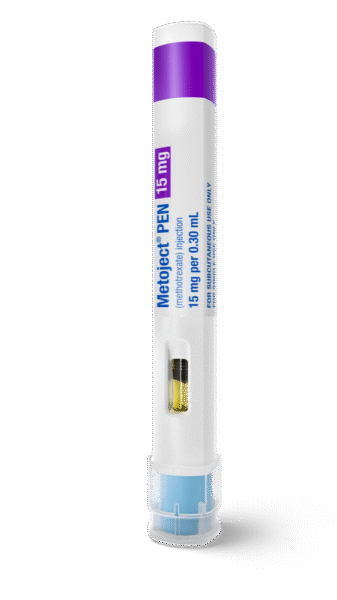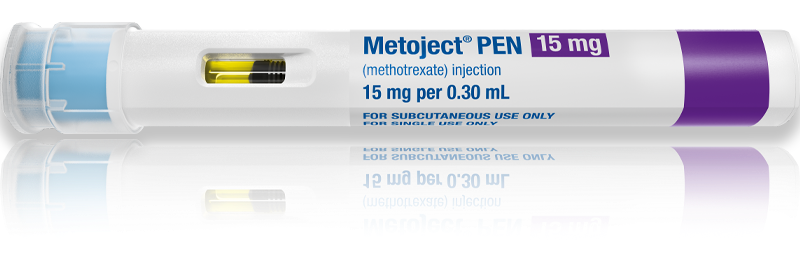Stomatitis
This webpage is intended for UK healthcare professionals. If you are not a healthcare professional, please click here.
Introducing the button-free Metoject® PEN

Offering the simplicity of a button-free autoinjector, purpose designed with patient-friendly features
Metoject® PEN For Dermatology
Metoject® PEN is used to treat moderate to severe psoriasis and severe psoriatic arthritis in adults.1
Considered as the ‘gold-standard’ by dermatologists, methotrexate is one of the most commonly prescribed drugs for the treatment of psoriasis.11 Subcutaneous methotrexate can improve symptoms and quality of life for psoriasis patients.12
Why use Metoject® PEN to Treat Psoriasis?
Clinical research has shown several benefits of Metoject® PEN and subcutaneous methotrexate administration, including:

The bioavailability of subcutaneous methotrexate is higher compared to oral methotrexate.1,3
In dosages between 7.5mg/m2 and 80mg/m2 body surface area, the bioavailability of subcutaneous methotrexate is nearly 100%, while the mean bioavailability of methotrexate absorbed from the gastrointestinal tract is approx. 70% with considerable inter- and intra-individual deviations.
Subcutaneous administration of methotrexate with Metoject® PEN resulted in a higher relative bioavailability compared to oral administration of methotrexate after single doses of 7.5mg, 15mg, 22.5mg, and 30mg.

More patients achieve a faster onset of response on subcutaneous (vs. oral) methotrexate.13
A study compared the clinical outcomes of oral vs. subcutaneous methotrexate in patients with moderate-to-severe psoriasis. By week 12, more patients reached PASI 50 with subcutaneous treatment than with oral. In patients with severe psoriasis, 82% (N = 51) patients reached PASI 50 in the subcutaneous group compared with 59% (N = 17) in the oral group.

More patients achieved a stable long-term response on subcutaneous dosing of methotrexate compared to oral.12,13
A recent study shows that when treating moderate to severe psoriasis, the total PASI 90 response rate at 52 weeks of treatment with subcutaneous methotrexate was 29.3%, while the total PASI 90 response rate at 52 weeks of treatment with oral methotrexate was 16%.13 This PASI 90 response rate of 29.3% was similar to the PASI 90 response rate of 27% observed at week 52 in the METOP study.

Patients suffer less frequent and less intense GI discomfort with subcutaneous administration. 4
A survey compared the frequency and intensity of nausea and frequency of gastrointestinal discomfort in rheumatoid arthritis patients treated with either oral or subcutaneous methotrexate. The results demonstrate that changing methotrexate dosing from oral to subcutaneous significantly reduced gastrointestinal adverse events.

Non-adherence of methotrexate is a frequent issue, which impacts the effectiveness of treatment.14
In a retrospective-cohort study in 8,952 patients with psoriatic arthritis, findings suggest that patients treated with oral formulations of methotrexate show significantly increased risk of non-adherence when compared with parenteral weekly treatment.
Metoject® PEN Support Materials & Information
Side Effects
Although subcutaneous (vs. oral) methotrexate is more tolerable, very common side effects include1:
Reporting Side Effects
Adverse events should be reported using the forms and information found at yellowcard.mhra.gov.uk
Please also report any adverse events by email to medac drug safety at drugsafety@medac.de
Further Information & Questions
Visit our contact page to submit an enquiryReferences:
- Metoject® Summary of Product Characteristics. [online] Available at: https://www.medicines.org.uk/emc/search?q=metoject#gref/. Last Accessed May 2023
- Müller, R.B. et al. (2015). Effectiveness, tolerability, and safety of subcutaneous methotrexate in early rheumatoid arthritis: A retrospective analysis of real-world data from the St. Gallen cohort. Seminars in Arthritis and Rheumatism, 45(1), pp.28–34.
- Pichlmeier, U., & Heuer, K. U. (2014). Subcutaneous administration of methotrexate with a prefilled autoinjector pen results in a higher relative bioavailability compared with oral administration of methotrexate. Clinical and experimental rheumatology, 32(4), 563–571.
- Kromann, C.B. et al. (2014). Does switching from oral to subcutaneous administration of methotrexate influence on patient reported gastro-intestinal adverse effects? Journal of Dermatological Treatment, 26(2), pp.188–190.
- EU Council Directive 2010/32/EU on the prevention of sharps injuries in the hospital and healthcare sector
- Latex data on file
- Braun, J. et al. (2008). Comparison of the clinical efficacy and safety of subcutaneous versus oral administration of methotrexate in patients with active rheumatoid arthritis: results of a six-month, multicenter, randomized, double-blind, controlled, phase IV trial. Arthritis and rheumatism, 58(1), 73–81.
- Methotrexate and its use in rheumatoid arthritis (RA). [online] Available at: https://nras.org.uk/resource/methotrexate/. Last Accessed May 2023.
- Johnson, T.M. et al. (2021). Investigating changes in disease activity as a mediator of cardiovascular risk reduction with methotrexate use in rheumatoid arthritis. Annals of the Rheumatic Diseases, [online] 80(11), pp.1385–1392.
- O’Connor, A. et al. (2016). The rapid kinetics of optimal treatment with subcutaneous methotrexate in early inflammatory arthritis: an observational study. BMC Musculoskeletal Disorders, 17(1).
- Kanwar, A., Yadav, S. and Dogra, S. (2010). Psoriasis: What is new in nonbiologic systemic therapy in the era of biologics? Indian Journal of Dermatology, Venereology, and Leprology, 76(6), p.622.
- Warren, R.B. et al. (2017). An intensified dosing schedule of subcutaneous methotrexate in patients with moderate to severe plaque-type psoriasis (METOP): a 52 week, multicentre, randomised, double-blind, placebo-controlled, phase 3 trial. The Lancet, 389(10068), pp.528–537.
- Reich, K. et al. (2020). The value of subcutaneous vs. oral methotrexate: real‐world data from the German psoriasis registry PsoBest. British Journal of Dermatology, 184(4), pp.765–767.
- Generali, E. et al. (2021). Non-adherence and discontinuation rate for oral and parenteral methotrexate: A retrospective-cohort study in 8,952 patients with psoriatic arthritis. Journal of Translational Autoimmunity, 4, p.100113.
